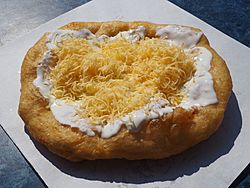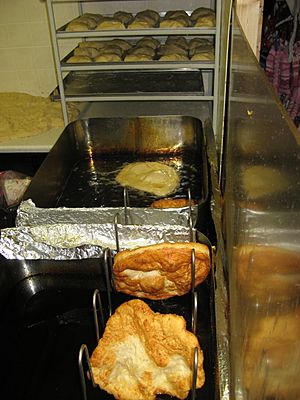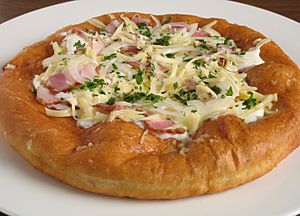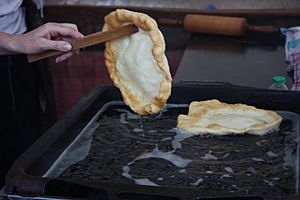Lángos facts for kids
 |
|
| Type | Fried flatbread |
|---|---|
| Main ingredients | Flour, yeast, salt |
Lángos (pronounced LAHN-gosh) is a super popular Hungarian food. It's a yummy deep-fried flatbread. Long ago, it was made from leftover bread dough. People baked it in front of a hot brick or clay oven. They ate it warm for breakfast on the day they baked bread.
Contents
What is Lángos?
Lángos is a delicious fried flatbread. It's a simple but tasty dish. Today, you can find it almost everywhere in Hungary. It's a favorite street food.
Where Did the Name Come From?
The name Lángos comes from the Hungarian word láng. Láng means 'flame'. This name makes a lot of sense. In the past, Lángos was baked by the flames of a hot oven. This was done while the oven was still getting hot for the main bread baking.
A Look Back: Lángos Through Time
In the past, families baked bread only once a week. This was because heating a big oven was expensive. They often baked smaller breads called "cipó" rolls. Lángos was made from the dough of these rolls. It was cooked quickly while the oven was still heating up. People also ate Lángos as a side dish for lunch.
After the 1950s, life in Hungary changed. People started buying bread from stores instead of baking at home. This meant less leftover dough for Lángos. So, traditional Lángos became less common.
In the late 1950s, small businesses were allowed again. Some people started selling a new kind of Lángos. This Lángos was fried in lard or sunflower oil. It became very popular. It was a top street food in the 1960s and 1970s.
At first, there were only a few kinds of Lángos. You could get it plain, with garlic and salt, or with cabbage or potato in the dough. In the 1980s, new kinds appeared. These included Lángos with sour cream and grated cheese. Later, in the 1990s, Lángos became popular again. Now, you can find many new kinds all over the world.
Delicious Lángos Variations
The dough for Lángos is simple. It's made from water or milk, flour, yeast, and salt. These ingredients are mixed together. The yeast helps the dough rise. This creates the air bubbles you see in Lángos. The dough is similar to pizza dough. But instead of baking, Lángos is fried in oil.
You can add things to the dough for extra flavor. Some people add sour cream, yogurt, or mashed potatoes. If you add mashed potatoes, it's called potato Lángos (krumplis lángos).
Lángos is best eaten fresh and warm. It often has toppings. Popular toppings include sour cream and grated cheese. You can also add Liptauer cheese, ham, or sausages. Many people just rub it with garlic or garlic butter. Sometimes, it's simply drizzled with garlic water. Other toppings can be mushrooms, quark cheese, eggplant, or cabbage. Some people even like it sweet with confectioner's sugar or jam.
In the early 2000s, some people started making "kenyérlángos." This means "bread-Lángos." They used small, portable clay ovens to bake it. You can find this at festivals and fairs. It's more like a pizza with sour cream, onions, and bacon.
Lángos is popular all year round. It's an affordable and simple food. You can often buy it near bus stations, at fairs, and in local markets. It's also popular in many Eastern European countries. You'll find it at celebrations or sports events.
Lángos is sold at many fast-food places. Not just in Hungary, but also in Austria. In Austria, especially Vienna, it's a popular fast food. You can find it at amusement parks like the Prater. Lángos is also known in the Czech Republic, Slovakia, and Croatia as langoš. In Serbia, it's languš. In Slovenia, it's Langaš. In Bulgaria, it's called Mekitsa. It's also very popular in Romania (especially Transylvania) as langoși. People in Poland call it "langosz." In the UK, it's known as "langos" or "Hungarian Fried Bread."
See also
 In Spanish: Lángos para niños
In Spanish: Lángos para niños




